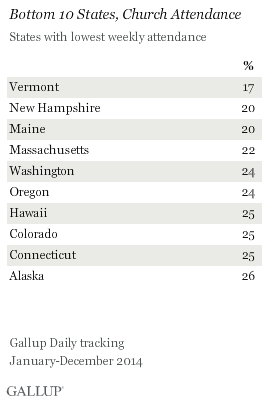Simsbury, Trumbull Are Best Communities for Young Families, Analysis Shows
/Simsbury, Trumbull, Kensington, Glastonbury and Orange are the best communities for young families in Connecticut, according to a new analysis by a national financial website.
“While parts of Connecticut have some of the highest housing costs in the country,” the website NerdWallet noted, their review of local data “found the communities in the Constitution State that offer young families the best combination of solid schools, great neighbors and affordability.”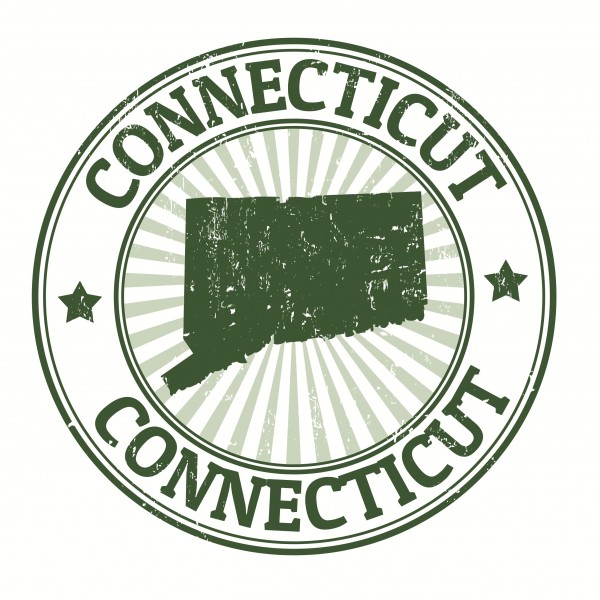
The analysis highlighted three main takeaways:
- Small towns are a good bet. Eight of the top 10 best cities for young families in Connecticut have populations of less than 30,000 residents.
- Schools add value. Even though eight of the top 10 cities have median home prices that are above the state median, the excellent schools help families get a solid return on their housing investment.
- Greater Hartford is a winner. Six of the 10 cities are near Hartford, the state’s capital.

The next five communities, following Orange, were Wethersfield, Newington, Winsted, Portland, and North Haven. West Hartford ranked #11, followed by Terryville (Southington), Bethel, Pawcatuck, Oakville (Watertown) and Shelton.
Data used in the analysis were from the 2013 U.S. Census Bureau’s American Community Survey. The factors that were considered include:
- Home affordability – the survey looked at median home value and selected monthly homeowner costs to prioritize affordable communities.
- Prosperity and growth - reviewing current and past family incomes, NerdWallet calculated the income of residents, as well as the projected long-term growth of each city.
- Quality of education - the ratings at GreatSchools.org were used to determine the best schools.
- Family friendliness - the percentage of families with school-age children and the poverty rate for young children. That measure was designed to help determine if an area is not only affordable for families, but if it is also a healthy one for children, NerdWallet explained.
NerdWallet analyzed the data for 47 places in Connecticut — cities, towns and census-designated places (such as Oakville and Terryville). Only places with over 5,000 residents were analyzed. The data was weighted 30 percent each for home affordability and family friendliness, 20 percent each for prosperity and growth, and quality of education.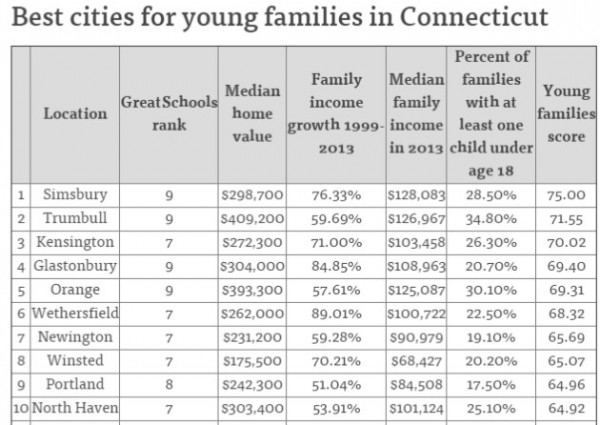
Simsbury topped the list “because it offers young families an outstanding combination of affordability and quality schools” and Trumbull earned the runner-up slot although it has “the most expensive housing in the top 10” because “young families get top value for their housing dollar.”
The website also pointed out that Wethersfield “has done exceptionally well economically in recent years: median family incomes have jumped 89% since 1999, the largest gain in the top 10” and Glastonbury residents “experienced an 85% jump in median income since 1999.”
Last year’s top 10 included Westport, Wallingford, Milford, Darien, and West Hartford, which all dropped out of the top 10. New to the top 10 this year were Winsted, Portland, Glastonbury, Kensington, and Simsbury. The population cut-off for last year’s list was 10,000; this year it was lowered to 5,000. Trumbull remained at #2 for the second consecutive year, while Orange slipped from #1 to #5. Simsbury, this year’s best town for young families, did not reach the top 10 a year ago, largely due to its population being under 10,000.



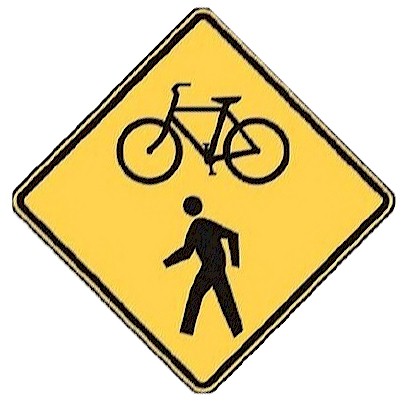
 motorized transportation networks and safety. Communities that routinely collect walking and biking data, they point out, are better positioned to track trends and prioritize investments.
motorized transportation networks and safety. Communities that routinely collect walking and biking data, they point out, are better positioned to track trends and prioritize investments.
 “We were excited here in Connecticut to give our Girl Scouts the opportunity to participate in a pilot of Digital Cookie, a first-of-its-kind web platform that lets girls sell cookies from their own protected, personalized websites,” said Tiffany Ventura Thiele, Communications & PR Manager for Girl Scouts of Connecticut.
“We were excited here in Connecticut to give our Girl Scouts the opportunity to participate in a pilot of Digital Cookie, a first-of-its-kind web platform that lets girls sell cookies from their own protected, personalized websites,” said Tiffany Ventura Thiele, Communications & PR Manager for Girl Scouts of Connecticut.
 Officials stress that “because 100 percent of the net revenue raised through the Girl Scout Cookie Program stays with local councils, when you purchase Girl Scout Cookies you’re not only getting a delicious treat — you’re also making an important investment in your community.”
Officials stress that “because 100 percent of the net revenue raised through the Girl Scout Cookie Program stays with local councils, when you purchase Girl Scout Cookies you’re not only getting a delicious treat — you’re also making an important investment in your community.”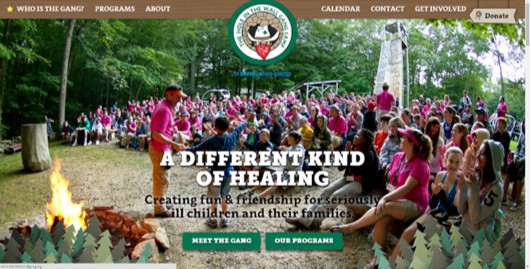
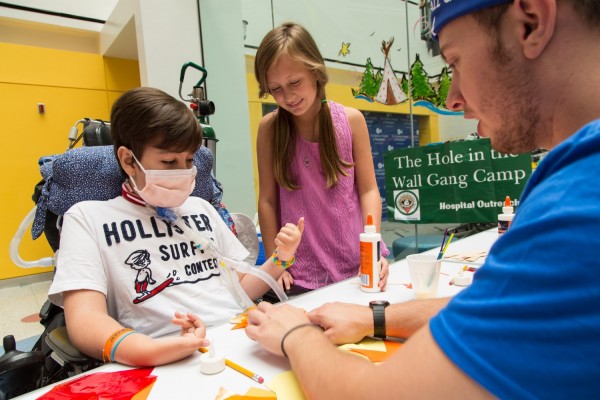
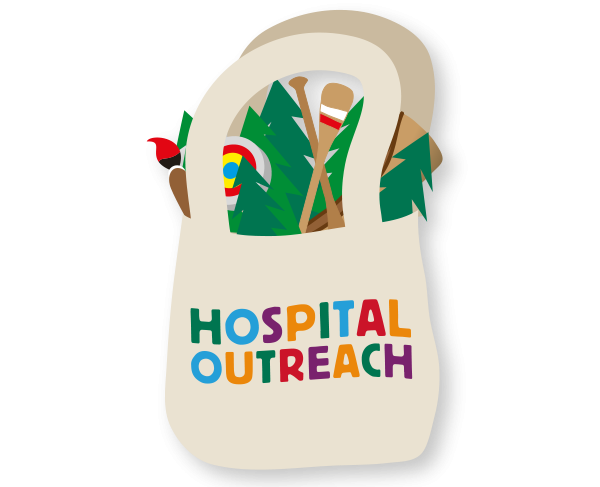 ll, there were “approximately 800 healing experiences with children and families throughout the week, bringing the safety, respect and love of Camp to many families” in Philadelphia.
ll, there were “approximately 800 healing experiences with children and families throughout the week, bringing the safety, respect and love of Camp to many families” in Philadelphia.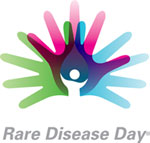

 iagnose, treat, and ultimately, cure NEC. Named after Morgan, it celebrates his survival, courage and strength. Morgan and his twin brother were born at 28 weeks, nearly three months early and each weighing less than 2.5 pounds. At four days old, Morgan developed NEC and lost approximately 20 percent of his small intestine. Morgan not only survived but has also thrived since his bout with NEC. The fund is his family’s way of paying it forward.
iagnose, treat, and ultimately, cure NEC. Named after Morgan, it celebrates his survival, courage and strength. Morgan and his twin brother were born at 28 weeks, nearly three months early and each weighing less than 2.5 pounds. At four days old, Morgan developed NEC and lost approximately 20 percent of his small intestine. Morgan not only survived but has also thrived since his bout with NEC. The fund is his family’s way of paying it forward.
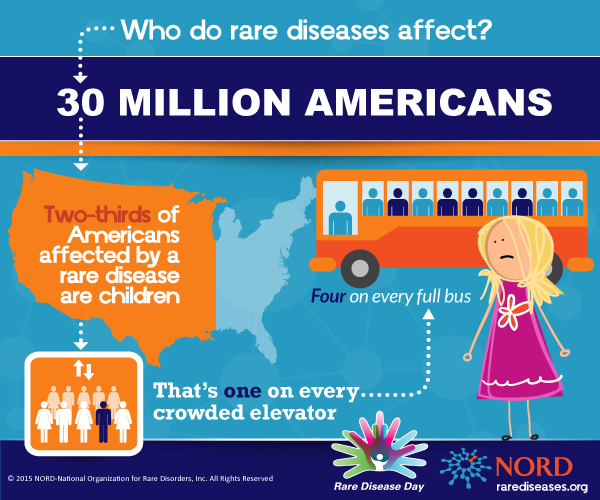


 “Hopefully this program will be a model for the rest of state,’’ Snedaker said. “Parents will now know their young children will have some of the same protections that benefit public middle and high school athletes.” In Norwalk, the newly approved guidelines had received support for the Norwalk Youth Football and Cheer, Norwalk Junior Soccer Association, Norwalk Cal Ripkin Baseball, Norwalk Little League and Norwalk Junior Lacrosse, according to the SportsCAPP website.
“Hopefully this program will be a model for the rest of state,’’ Snedaker said. “Parents will now know their young children will have some of the same protections that benefit public middle and high school athletes.” In Norwalk, the newly approved guidelines had received support for the Norwalk Youth Football and Cheer, Norwalk Junior Soccer Association, Norwalk Cal Ripkin Baseball, Norwalk Little League and Norwalk Junior Lacrosse, according to the SportsCAPP website.
 elephant venues and out-of-control costs that have plagued Olympic hosts for decades.” Recently adopted IOC guidelines are aimed at reducing costs by host cities and are more amenable to having some events take place outside the immediate Olympic perimeter.
elephant venues and out-of-control costs that have plagued Olympic hosts for decades.” Recently adopted IOC guidelines are aimed at reducing costs by host cities and are more amenable to having some events take place outside the immediate Olympic perimeter. s far on whether such a tour has been scheduled. Possible sports at the Connecticut venues, as suggested by CRDA, include badminton, table tennis, wrestling, martial arts, and weightlifting. Basketball, volleyball and soccer could be additional possibilities, along with tennis. The Connecticut Tennis Center is described as the fourth largest tennis venue in the world, with seating capacity of 15,000. Within the past week, options for major renovations or reconstruction of Hartford’s XL Center have been announced, with a decision on how to proceed due later this year.
s far on whether such a tour has been scheduled. Possible sports at the Connecticut venues, as suggested by CRDA, include badminton, table tennis, wrestling, martial arts, and weightlifting. Basketball, volleyball and soccer could be additional possibilities, along with tennis. The Connecticut Tennis Center is described as the fourth largest tennis venue in the world, with seating capacity of 15,000. Within the past week, options for major renovations or reconstruction of Hartford’s XL Center have been announced, with a decision on how to proceed due later this year. opened a state-of-the-art 300,000 square foot facility headquartered in
opened a state-of-the-art 300,000 square foot facility headquartered in 



 tently and robustly in research.” Describing Connecticut as “the home of innovation in engineering,” Esty said that engineers provide “the inspiration to solve the world’s problems.”
tently and robustly in research.” Describing Connecticut as “the home of innovation in engineering,” Esty said that engineers provide “the inspiration to solve the world’s problems.” Among the faculty award recipients was Dr. Alfred A. Gates, Professor of Engineering at Central Connecticut State University, whose two decades at the university have been a steady stream of technical innovation and teaching. Gates noted that CCSU has just become the first university in the United States to receive a
Among the faculty award recipients was Dr. Alfred A. Gates, Professor of Engineering at Central Connecticut State University, whose two decades at the university have been a steady stream of technical innovation and teaching. Gates noted that CCSU has just become the first university in the United States to receive a 
 are stark geographic differences in religiosity. In some states of the union -- Utah and Southern states -- roughly half of residents report attending religious services weekly, while in others -- mostly in the Northeast and the West -- a fourth or less of residents attend weekly.”
are stark geographic differences in religiosity. In some states of the union -- Utah and Southern states -- roughly half of residents report attending religious services weekly, while in others -- mostly in the Northeast and the West -- a fourth or less of residents attend weekly.”